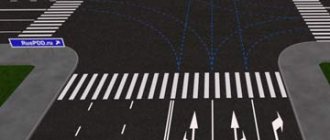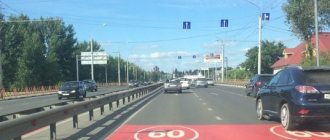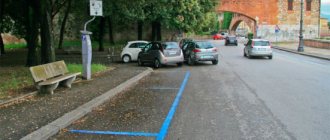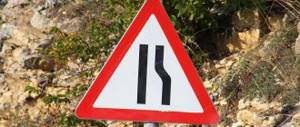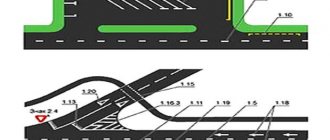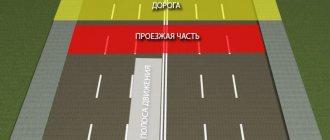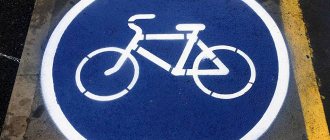Author: ARON
17 January 2021 13:20
Community: Autoworld
Tags: traffic rules reminder, markings
8828
5
There is nothing in the traffic rules that was done just for fun or for beauty. Especially when it comes to road markings.
0
See all photos in the gallery
For a second, it is the most effective tool for regulating relations between motorists and pedestrians. Yellow markings occupy a special place in the rules today. There are three schemes in which yellow is used as a mandatory color. In another, yellow is the recommended color.
What types of road markings exist by color and their designations
All types of road markings are divided into two large groups:
- constant;
- temporary.
Another criterion used to separate this type of designation is the color of the paint applied to the asphalt. To make the signs on the road more visible and more contrasting, white is used, however, in some cases lines of yellow, orange, blue and other colors are used.
According to the requirements of GOST 51259-2018, the following colors can be used on the roadway:
- White and yellow - to create noticeable dividing lines separating oncoming and passing flows. Yellow is more visible under a layer of snow or in bad weather conditions. Also, this shade is used to make “waffle irons” at intersections, places with prohibited parking and to mark pockets for public transport.
- Blue - used to delimit traffic in areas of multi-lane intersections and determine the boundaries of parking lots. The priority of this marking is determined not by its color, but by its shape: only a broken line can be crossed with impunity.
- Orange – used for temporary delimitation of traffic lanes. Used during repair work and has priority over road signs.
- Black - applied exclusively to vertical structures (curbs and pillars), not for lines on asphalt.
Road marking law
A description of the markings is contained in Appendix No. 2 to the Traffic Regulations. Horizontal lines are regulated by 1 section of the document. In it you can see a link to GOST R 51256-2011. It is according to this that the lines are numbered.
In 2021, CITI Dorcontrol LLC developed new standards. Today GOST R 51256-2011 has been replaced by another regulatory document - GOST 51256-2018. The previous one has become invalid. It turns out that the Road Traffic Rules still refer to a standard that no longer exists.
The previous document did state that all permanent markings (except lines 1.4, 1.10 and 1.17) should be white. The new GOST provides for both white and yellow lines. Thus, we see another gap in the law that needs to be resolved.
What should the yellow markings be like?
If yellow markings belong to the category of permanent designations, then they may indicate:
- pockets designed for boarding/disembarking public transport passengers;
- places where parking and stopping of vehicles is prohibited, in addition to signs 3.27 and 3.28;
- manholes, storm drains and drains on the roadway (extremely rare).
Types of road markings
The yellow line on the asphalt can be made in several ways:
- Solid. It is used to mark the roadside and is applied 20 cm from curbs or sidewalks for pedestrians. Used for places where parking of vehicles is prohibited, together with the signs “Stopping is prohibited” and “Parking is prohibited”. Occasionally used as a stripe to separate oncoming traffic (similar to a solid white line). The latter option is used in regions with snowy winters for better visibility.
- In the shape of a zigzag. According to paragraph 1.17 of the traffic rules, a broken line indicates the location of a public transport stop. For other road users, parking in the specified zone and 15 meters from it is prohibited. Also, reversing and turning around are prohibited in this area.
- Broken line. When applied on the roadsides and edges of the sidewalk, it means a parking ban (clause 1.10 of the traffic rules). On country roads, such a sign on the right side prohibits driving on the side of the road.
- In the form of squares or “waffle irons”. They are used only at the intersection of roadways to indicate a zone where stopping is prohibited.
Application options
Yellow markings can be applied as follows:
- horizontally - this group includes all types of markings on asphalt: solid, broken and broken lines;
- vertically. Yellow color is used in this way extremely rarely. It can indicate dangerous areas (protruding hatches or poles), and the yellow color can be applied to curbs.
What do yellow road markings mean?
Yellow markings on the road are quite common and have a certain meaning, which we will discuss in the article.
But first you need to know what markup is and what it is intended for.
Road markings are applied for several purposes:
- Serves as a complement to road signs.
- Can warn you when approaching a variety of road signs.
- It indicates that dangerous sections of the road are located nearby.
- It delimits the roadway and serves as a separator for traffic lanes.
More detailed information can be obtained by opening the traffic rules, which contain information about horizontal markings.
Markings may vary in color:
- White markings are permanent and are applied in most cases to mark the edge of the roadway and divide the roadway into stripes. It can be intermittent or continuous, and also mark a pedestrian crossing or serve as a stop line before a traffic light, crossing or pedestrian crossing.
- The orange markings are temporary. Most often it is applied if there are road works going on somewhere nearby and there is a need to change the permanent markings in order to ensure safety or better passability of the route.
- Yellow markings are permanent and are used along with white markings to achieve good visibility . It can be found at bus stops, along roadsides, at pedestrian crossings along with white markings.
Yellow line on the road
If you are soon to take a driver's license exam, then in the test questions you probably came across a question regarding yellow markings.
Most often, such a strip is depicted on the side of the road, and the ticket asks whether it is possible to park or stop on this section of the road.
The article answers the question regarding the meaning of yellow markings, what they mean and the responsibility of drivers for non-compliance with traffic rules.
What does the yellow marking mean?
Yellow markings serve to complement road signs that prohibit stopping or parking of cars. Traffic rules regarding yellow markings are established in paragraphs 3.27 and 3.28 of the Traffic Regulations.
At the moment, there are only three types of yellow markings, remembering the meaning of which will not be difficult.
However, we should not forget how important it is. Otherwise, there is a possibility of receiving a fairly large fine or forced evacuation of the car.
The fact is that cars parked in a place not intended for these purposes can be evacuated and taken to the parking lot.
In this case, you will have to pay a tidy sum for parking.
So, let's look at the types of yellow markings:
- A continuous line drawn next to a curb or the side of a road. If you see such a line, then parking in this place is prohibited, and you also cannot stop here. Moreover, it is prohibited to leave a car in this area for more than five minutes.
- A broken line indicates that parking is not allowed in this location . Please note that you can stop or leave your car on such sections of roads, but no more than 5 minutes. This line most often serves as a complement to the 3.28 sign.
- A yellow zigzag line is depicted at public transport and taxi stops. It is prohibited to stop and park in these areas.
It is important to keep in mind that sign 3.28 allows you to stop on the indicated section of the road and pick up or unload passengers. It is also not prohibited to stop in emergency cases as a result of car breakdowns or other situations. Such cases also include serious health problems and insurmountable obstacles on the road section.
You also need to know that intermittent and solid yellow markings can be applied along the edge of the roadway outside the city.
In this case, you should under no circumstances cross it or stop or park next to it, otherwise you will violate restrictions on driving on the side of the road.
In the place where the marking ends, you can park or stop if there are no road signs prohibiting this.
Fines
Let's consider the issue of fines provided for parking within the yellow markings or crossing them.
If the line is drawn along the side of the road outside a populated area, then if it is crossed, a fine of 1,500 rubles will be imposed.
If such a violation is committed within a populated area, then you will also have to pay 1,500 rubles for residents of Russian regions and 3,000 rubles for residents of Moscow and the northern capital.
If you parked in a yellow marking area, your car may be towed into a parking lot without your consent..
In this case, it will be necessary to pay both the amount of the fine imposed for violating parking rules and the money for finding the car in a parking lot.
Source: https://autojurist911.ru/ostalnoe/zheltaya-dorozhnaya-razmetka.html
Do cameras record violations of road markings?
In modern conditions, there are two types of offenses related to crossing yellow markings, which are recorded by automatic cameras:
- Exit and drive along the side of the road marked with a yellow line. In this case, the type of shoulder does not matter: asphalt or unpaved. Thanks to the cameras, the number of drivers who avoid traffic jams on the side of the road is reduced. The fine for such a violation is 1,500 rubles.
- Departure and stop at the “waffle iron”. Stopping at the intersection is prohibited; markings of intersecting yellow lines are used to indicate the area where the restriction applies. In order for such a stop to be considered an offense, it is necessary to leave or not have time to leave the marked area after the activation of the prohibitory traffic light signal. The penalty for violators of this rule is 1000 rubles.
Possible fine for violation
For violation of yellow marking requirements, administrative liability is provided:
- intersection of a single line (solid or broken). In Moscow or St. Petersburg it is punishable by a fine of 3,000 rubles; in other regions of Russia the fine is 1,500 rubles. For parking in this area, the violator’s car may be towed to the impound lot;
- for ignoring the benefits of public transport that departs from a broken line (stop) - a fine of 500 rubles;
- ignoring traffic rules requirements to give way to pedestrians crossing the road along a yellow zebra crossing - a monetary penalty of 1,500 rubles;
- turning around or reversing in an area marked with a zigzag - 500 rubles;
- overtaking on a yellow zebra crossing, crossing a solid line dividing traffic flows - a monetary penalty of 5,000 rubles or deprivation of the right to drive for up to six months;
- leaving and stopping at a “waffle iron” at a prohibiting traffic light – a monetary penalty of 1,000 rubles;
- leaving and driving along the side of the road while ignoring the yellow line on the right edge - a fine of 1,500 rubles.
Signage prohibiting stopping or parking
The following types can be considered as markings prohibiting stopping or parking of vehicles:
All these marking lines are painted with yellow paint. Please note that temporary marking lines are painted with orange paint. Since yellow and orange lines are not very common on the roads, not all drivers can distinguish them.
Therefore, I will repeat it again. Orange lines indicate temporary markings, and yellow lines indicate permanent markings.
Marking 1.4 prohibits stopping vehicles.
Marking 1.10 prohibits parking of vehicles.
These marking lines can be applied both along the curb (at the edge of the roadway) and directly along its top.
In 2021, for violating the requirements of one of the above types of markings, the driver may be subject to an administrative fine in the amount of 1,500 rubles (3,000 rubles in Moscow and St. Petersburg).
Marking 1.17 indicates stopping places for route vehicles or taxi ranks. In the area covered by this marking, the same rules apply as at any other public transport stop.
For example, you can stop there only to pick up or unload passengers, without interfering with route vehicles.
If the line is not visible, is the penalty applied?
Any markings may be covered with snow or may be erased in high-traffic areas. Many motorists wonder whether the fine imposed in this case is legal.
In order to understand this issue, it is necessary to take into account several circumstances:
- If there are four or more lanes on the roadway, the markings of which are poorly visible due to snow or other conditions, the driver is responsible for making an independent decision about the correct placement of his vehicle on the road. In this case, a fine will be imposed for violating the traffic rules.
- If the road has less than four lanes and there are no additional road signs, then imposing a fine in this situation is unlawful.
In order to challenge the punishment imposed by the traffic police inspector, you must warn the employee of your disagreement with his decision and make a corresponding note in the protocol. Subsequently, you will need to provide evidence of your innocence during the trial.
| Did not find an answer to your question? Call a lawyer! Moscow: +7 (499) 110-89-42 St. Petersburg: +7 (812) 385-56-34 Russia: +7 (499) 755-96-84 |
For the last few years, yellow markings on Russian roads have been used along with white markings. Such lines on the asphalt can prohibit parking, delimit traffic flows and indicate an area at an intersection where stopping is prohibited. For violation of these requirements, drivers are subject to a fine.
What do yellow markings on the road mean, requirements and fines?
According to the traffic rules (traffic rules), there are white, orange and yellow markings. It guides vehicle drivers and pedestrians on the roadway. Yellow was introduced relatively recently, and not everyone knows about its meaning. The main types, requirements and administrative liability for violation of the rules will be discussed later in the article.
What does yellow marking mean?
The yellow stripe is a type of permanent marking. Most often, she draws the driver’s attention to:
- public transport stops;
- areas with restrictions when parking or stopping vehicles;
- water drains and hatches.
Thus, it is in addition to signs 3.27 and 3.28 of the traffic rules. Drivers who are not familiar with these types of adjustments are advised not to stop or park in such places. This will help avoid unpleasant consequences in the form of a fine.
Types of markup
There are several marking options: solid, zigzag and intermittent, so remembering their meaning will not be difficult. What each line warns about can be found out below.
Solid
A yellow solid stripe is applied along the curbs at a distance of 20 cm or along the edge of the sidewalk. Indicates the prohibition of parking/stopping of any vehicles (except for special vehicles) in the application area and is displayed in the traffic rules under paragraph 1.4.
Often the markings are supplemented with a “No Stopping” road sign (Section 3.27 of the Traffic Regulations). In this case, the sign ceases to be valid at the end of the road application. In this case, you can take advantage of the presence of “corridors”.
Sections of the curb where the line is interrupted can be used for parking (provided that the parked car does not interfere with pedestrians and other vehicles).
Intermittent
A broken yellow line on the roadsides and sidewalks means parking is prohibited in a given location (Section 1.10 of the Traffic Regulations). Often an additional “No parking” sign is installed (clause 3.28). On such a section, only a temporary stop is possible (up to 3 minutes).
Crossing a line or stopping before a marking on country roads is prohibited and is considered the same as driving on the side of the road.
Requirements
Every driver, seeing a yellow horizontal line, knows that parking or stopping in the marked area is prohibited. But few people know how many requirements the applied markings have.
So, the main ones include:
- The solid line (1.4) must be applied with a thickness of no more than 15 mm and prohibits stopping vehicles. It is allowed to make technological breaks up to 50 mm long with a distance between them of more than 20 m.
- Any yellow horizontal markings must be 60mm above ground level.
- Lines drawn with paint or enamel must last at least three months; the durability of thermoplastic markings (at least 15 mm thick) must last more than 1 year.
- The length of the strokes of the old marking lines should not protrude more than 50 mm from the updated line (in case the previous yellow stripe is outdated and needs to be reapplied). For other geometric parameters, the permissible difference between the lines is up to 1 cm.
- Horizontal markings undergo control of color coefficient, brightness and retroreflection, in accordance with GOST R 54809.
